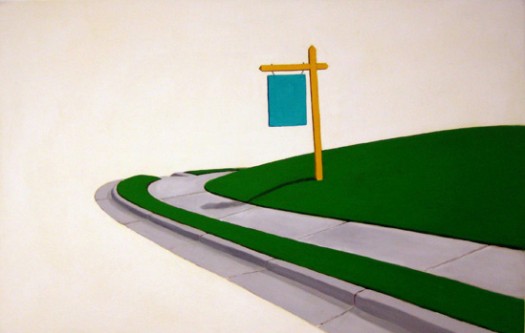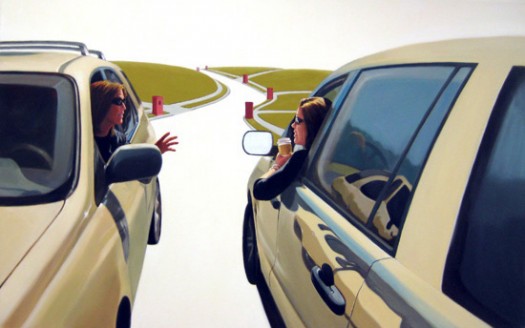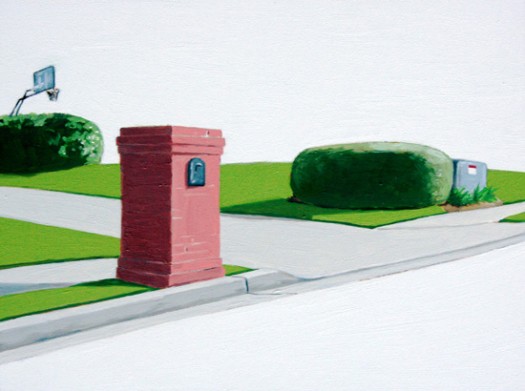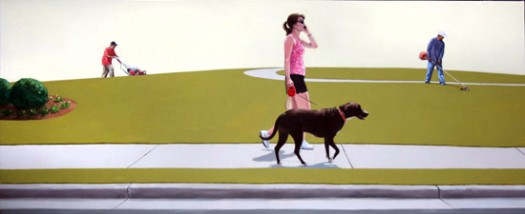A Placemaking Journal
I Just Live Here: Welcome to the suburbs, deconstructed
Taking shots at the suburbs is like playing bass in a garage band: Easy to do, but hard to do well. After all, their original intent — an idyllic melding of town and country, with all the advantages of both — implied a tranquil, family-friendly promise that, over time, has proven notoriously unfulfilled.
Surely that’s a subject worthy of more than just another McMansion joke.
The last time I considered this issue I was writing about Arcade Fire’s “The Suburbs,” a poignant reflection from someone raised there now confronting the reality of mourning its loss. Not, as I said then, in a nostalgic way that denies the suburbs’ ultimate failings but in a way that honors their original goal: creating a place where people could live, thrive and be happy.
Today I turn from ear to eye candy with artist Meg Aubrey’s recently resurfaced I Just Live Here series, now on display in the T-Concourse of Atlanta’s Hartsfield-Jackson International Airport as part of its contemporary Atlanta artists program.

Aubrey, like Arcade Fire’s Win Butler, is no outsider. As a resident of Atlanta’s northern suburbs, she’s both observer and participant which, in some strange way, has influenced a series of works simultaneously scathing in their deconstruction and oddly empathetic in their treatment.
Here’s how Ms. Aubrey sees it:
The recognizable objects of suburbia: landscaping, sidewalks, trash cans, and brick mailboxes, permeate my paintings. The landscapes contain desperately controlled and perfectly presented elements of an environment created to hold back the engulfing emptiness of a life full of living up to expectations. I investigate neighborhoods full of successful individuals who use outward appearance to express their achievements yet the reality is that the promise of an idyllic lifestyle filled with beauty, friendship, and security is not always found at the end of the cull de sac. The female figure, forty something, well dressed, seemingly without a care, inhabits the environment and searches for her purpose in life. College educated with work experience, she now fills her days with tennis, errands, PTA, car pools, and other activities that are a substitute for the career she might have had. Shown without husbands or children, although they are clearly implied, she has become the stereotype of the upper middle class housewife. This body of work examines and deconstructs this environment, pulling apart the individual elements to tell stories of daily suburban existence.

Things are especially interesting from a placemaking perspective, as a defining characteristic of our most loved places is the manner in which the whole emerges as something greater than the sum of its parts. At the component level, it might be a street, some buildings, places to live and work and yet, together, they become something much more than that. Something magical.
But Aubrey presents the exact opposite: A world where our surroundings are actually less than the sum of their parts. Individually, you might have innocuous items like a mailbox, manicured shrub, basketball hoop or utility box. But combine them and something new, and decidedly less inviting, emerges: A barren and soulless landscape revealing an uncomfortable subtext of raw ennui.

These awkward affiliations extend beyond environmental forms to the people themselves. I’ve heard it said that traditional urbanism doesn’t create community but, for those looking to connect with others and the world around them, it makes it a whole lot easier. Contrast that with Aubrey’s world, which seems to ruthlessly reinforce at every turn the divisions we subconsciously, and consciously, impose based on economics, class and race.

I really love this show and, like all absorbing art, I’m not entirely sure why. Perhaps it’s the way in which it confronts the original promise of what the suburbs could have been — traditional urban forms at a more bucolic and decidedly less intense scale — detailed so well in Kenneth Jackson’s “Crabgrass Frontier: The Suburbanization of the United States.”
We had an idea then that — viewed in the full context of human settlement, from the most rural to the most urban — could have provided another meaningful choice in a complex array of lifestyle and community types. Instead, we adopted it wholesale as our one-size-fits-all development pattern, turned it over to the car and, in the process, diluted any sense of human-scaled character it might have once possessed.
Check out the entire series here. What does it say to you?
–Scott Doyon
If PlaceShakers is our soapbox, our Facebook page is where we step down, grab a drink and enjoy a little conversation. Looking for a heads-up on the latest community-building news and perspective from around the web? Click through and “Like” us and we’ll keep you in the loop.









